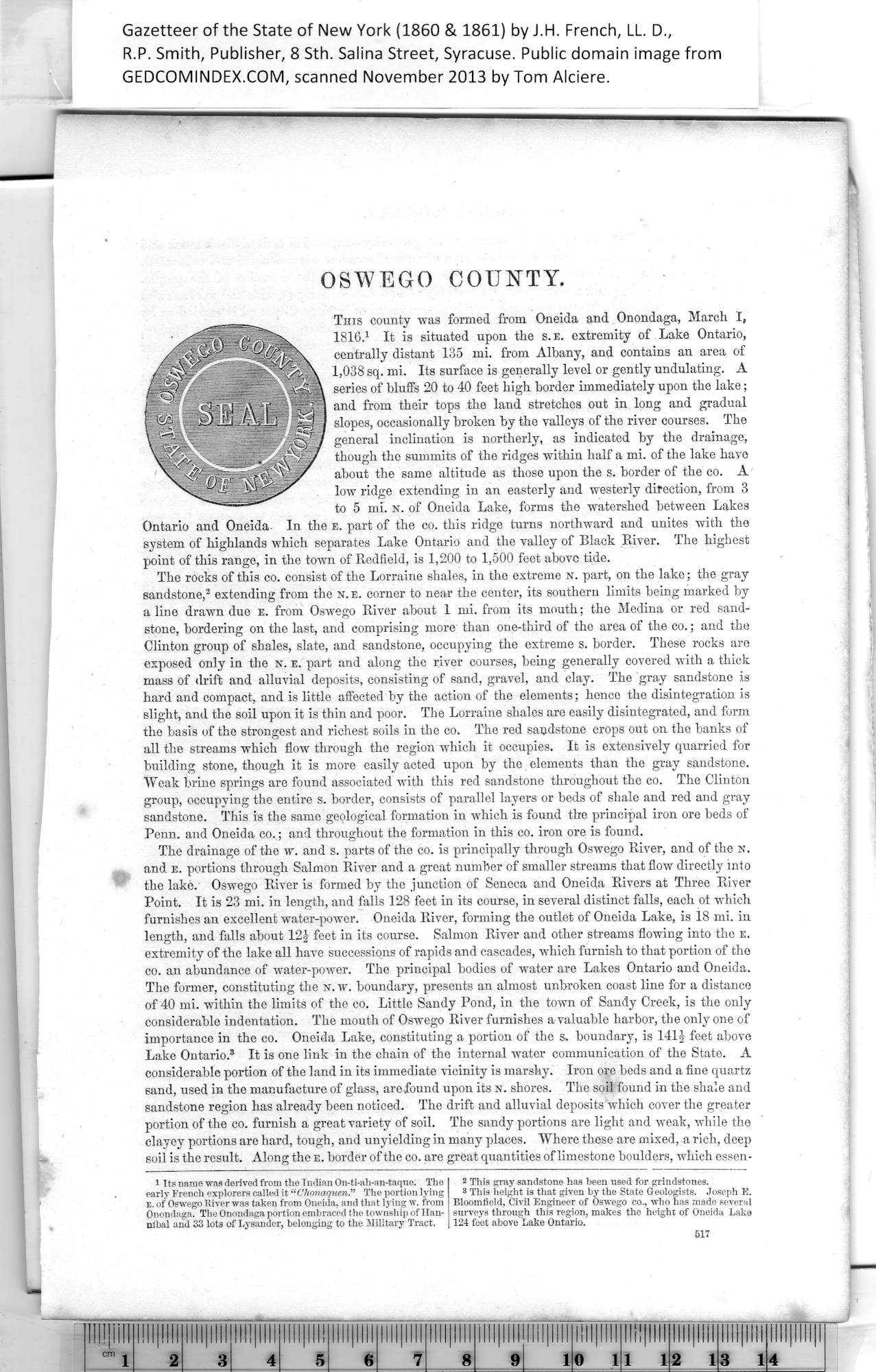|
OSWEGO COUNTY.
This county was formed from Oneida and Onondaga, March I,
1816.1 It is situated upon the s.e. extremity of Lake Ontario,
centrally distant 135 mi. from Albany, and contains an area of
1,038 sq. mi. Its surface is generally level or gently undulating. A
series of bluffs 20 to 40 feet high border immediately upon the lake;
and from their tops the land stretches out in long and gradual
slopes, occasionally broken by the valleys of the river courses. The
general inclination is northerly, as indicated by the drainage,
though the summits of the ridges within half a mi. of the lake haye
about the same altitude as those upon the s. border of the co. A
low ridge extending in an easterly and westerly direction, from 3
to 5 mi. n. of Oneida Lake, forms the watershed between Lakes
Ontario and Oneida- In the e. part of the co. this ridge turns northward and unites with the
system of highlands which separates Lake Ontario and the valley of Black River. The highest
point of this range, in the town of Redfield, is 1,200 to 1,500 feet above tide.
The rocks of this co. consist of the Lorraine shales, in the extreme n. part, on the lake; the gray
sandstone,2 extending from the n.e. corner to near the center, its southern limits being marked by
a line drawn due e. from Oswego River about 1 mi. from its mouth; the Medina or red sand¬
stone, bordering on the last, and comprising more than one-third of the area of the co.; and the
Clinton group of shales, slate, and sandstone, occupying the extreme s. border. These rocks are
exposed only in the n. e. part and along the river courses, being generally covered with a thick
mass of drift and alluvial deposits, consisting of sand, gravel, and clay. The gray sandstone is
hard and compact, and is little affected by the action of the elements; hence the disintegration is
slight, ami the soil upon it is thin and poor. The Lorraine shales are easily disintegrated, and form
the basis of the strongest and richest soils in the co. The red sandstone crops out on the banks of
all the streams which flow through the region which it occupies. It is extensively quarried for
building stone, though it is more easily acted upon by the elements than the gray sandstone.
Weak brine springs are found associated with this red sandstone throughout the co. The Clinton
group, occupying the entire s. border, consists of parallel layers or beds of shale and red and gray
sandstone. This is the same geological formation in which is found the principal iron ore beds of
Penn, and Oneida co.; and throughout the formation in this co. iron ore is found.
The drainage of the w. and s. parts of the co. is principally through Oswego River, and of the N.
and e. portions through Salmon River and a great number of smaller streams that flow directly into
the lake. Oswego River is formed by the junction of Seneca and Oneida Rivers at Three River
Point. It is 23 mi. in length, and falls 128 feet in its course, in several distinct falls, each ot which
furnishes an excellent water-power. Oneida River, forming the outlet of Oneida Lake, is 18 mi. in
length, and falls about 12J feet in its course. Salmon River and other streams flowing into the e.
extremity of the lake all have successions of rapids and cascades, which furnish to that portion of the
co. an abundance of water-power. The principal bodies of water are Lakes Ontario and Oneida.
The former, constituting the n. w. boundary, presents an almost unbroken coast line for a distance
of 40 mi. within the limits of the co. Little Sandy Pond, in the town of Sandy Creek, is the only
considerable indentation. The mouth of Oswego River furnishes a valuable harbor, the only one of
importance in the co. Oneida Lake, constituting a portion of the s. boundary, is 141J feet above
Lake Ontario.3 It is one link in the chain of the internal water communication of the State. A
considerable portion of the land in its immediate vicinity is marshy. Iron ore beds and a fine quartz
sand, used in the manufacture of glass, are found upon its n. shores. The soil found in the shale and
sandstone region has already been noticed. The drift and alluvial deposits which cover the greater
portion of the co. furnish a great variety of soil. The sandy portions are light and weak, while the
clayey portions are hard, tough, and unyielding in many places. Where these are mixed, a rich, deep
soil is the result. Along the e. border of the co. are great quantities of limestone boulders, which essen-
|
2 This gray sandstone has been used for grindstones.
3 This height is that given by the State Geologists. Joseph E.
Bloomfield, Civil Engineer of Oswego co., who has made several
surveys through this region, makes the height of Oneida Lake
124 feet above Lake Ontario. |
1
Its name was derived from the Indian On-ti-ah-an-taque. The
early French explorers called it “C'honaquen.” The portion lying
E. of Oswego Kiver was taken from Oneida, and that lying w. from
Onondaga. The Onondaga portion embraced the township of Han¬
nibal and 33 lots of Lysander, belonging to the Military Tract.
|
